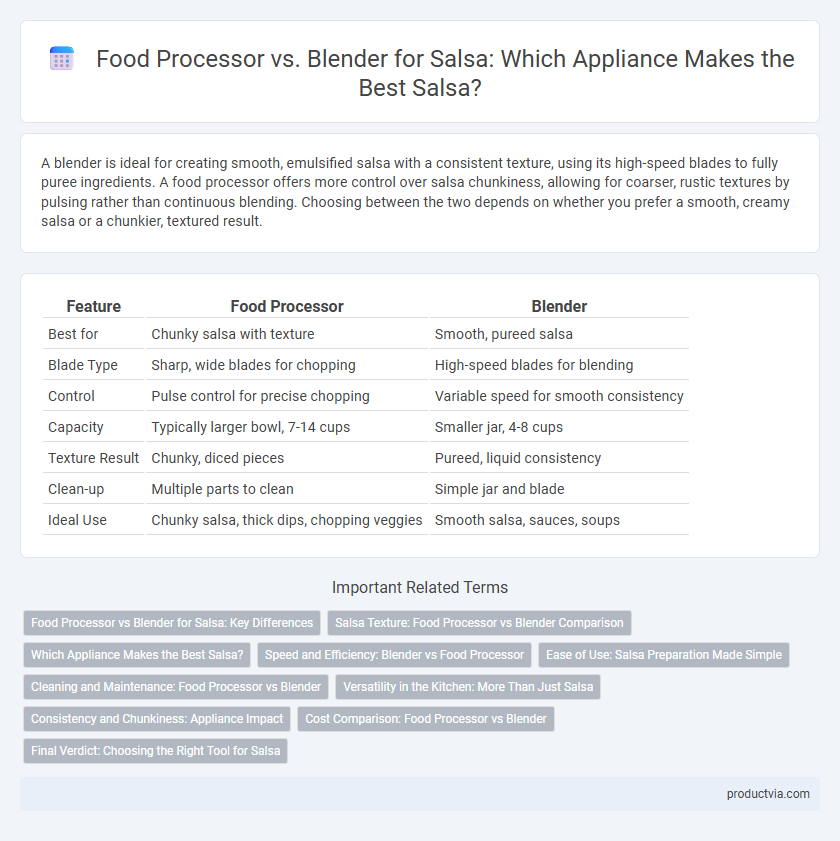A blender is ideal for creating smooth, emulsified salsa with a consistent texture, using its high-speed blades to fully puree ingredients. A food processor offers more control over salsa chunkiness, allowing for coarser, rustic textures by pulsing rather than continuous blending. Choosing between the two depends on whether you prefer a smooth, creamy salsa or a chunkier, textured result.
Table of Comparison
| Feature | Food Processor | Blender |
|---|---|---|
| Best for | Chunky salsa with texture | Smooth, pureed salsa |
| Blade Type | Sharp, wide blades for chopping | High-speed blades for blending |
| Control | Pulse control for precise chopping | Variable speed for smooth consistency |
| Capacity | Typically larger bowl, 7-14 cups | Smaller jar, 4-8 cups |
| Texture Result | Chunky, diced pieces | Pureed, liquid consistency |
| Clean-up | Multiple parts to clean | Simple jar and blade |
| Ideal Use | Chunky salsa, thick dips, chopping veggies | Smooth salsa, sauces, soups |
Food Processor vs Blender for Salsa: Key Differences
Food processors and blenders differ significantly in their ability to prepare salsa; food processors excel in chopping ingredients into coarse, chunky textures, while blenders produce a smoother, more liquid consistency. The wider bowl and sharper chopping blades of a food processor allow for better control over salsa texture, making it ideal for fresh salsa with distinct vegetable pieces. Conversely, blenders's high-speed rotary blades can over-process the ingredients, resulting in a puree rather than a traditional salsa.
Salsa Texture: Food Processor vs Blender Comparison
A food processor produces a chunkier salsa texture by finely chopping ingredients without over-pureeing, maintaining distinct vegetable pieces for a rustic feel. A blender, by contrast, creates a smoother, more uniform salsa consistency due to its high-speed blades emulsifying the ingredients into a sauce-like blend. Choosing between a food processor and blender depends on whether a coarse or smooth salsa texture is preferred for recipes.
Which Appliance Makes the Best Salsa?
A blender creates smoother salsa by rapidly pureeing ingredients, delivering a consistent texture ideal for creamy dips. A food processor, with its wider bowl and sharp blades, offers better control over chunkiness, preserving a coarser, more traditional salsa consistency. For salsa enthusiasts seeking a blend of texture and customization, a food processor typically yields the best results.
Speed and Efficiency: Blender vs Food Processor
A blender typically processes salsa ingredients faster with high-speed blades that pulverize components into a consistently smooth texture. Food processors, equipped with wider bowls and variable blade attachments, offer more control over chunkiness but require longer processing times for evenly blended salsa. For speed and efficiency in creating quick, smooth salsa, blenders outperform food processors by delivering uniform results in seconds.
Ease of Use: Salsa Preparation Made Simple
A food processor offers superior ease of use for salsa preparation due to its wider bowl and sharp blade design, enabling quick chopping and consistent texture control. Blender settings can be less precise, often resulting in smoother purees rather than the chunky consistency desired in traditional salsa. With intuitive speed controls and pulse functions, food processors streamline the salsa-making process, minimizing prep time and cleanup.
Cleaning and Maintenance: Food Processor vs Blender
Food processors generally require more time for cleaning due to multiple detachable parts and intricate blades, making maintenance slightly more complex. Blenders typically feature fewer components and a simpler design, allowing for quicker cleaning and easier upkeep after making salsa. Choosing a blender can minimize post-preparation cleaning effort, while food processors might need extra care to maintain all parts efficiently.
Versatility in the Kitchen: More Than Just Salsa
A blender's powerful motor and multiple speed settings make it ideal for creating smooth salsas, purees, and soups, while a food processor excels at chopping chunky ingredients and can handle tasks like slicing, shredding, and kneading dough. Food processors offer versatility for prepping a variety of ingredients beyond salsa, such as vegetables for salads or dough for bread. Both appliances complement each other in a kitchen, enhancing efficiency across diverse culinary applications.
Consistency and Chunkiness: Appliance Impact
Blenders produce a smoother, more liquid consistency ideal for pureed salsas, while food processors retain chunkier textures due to their pulsing action and wider blades. Food processors allow greater control over chunk size, making them better suited for chunky salsas that benefit from uneven ingredient cuts. The appliance choice directly affects the salsa's mouthfeel and presentation, with blenders excelling in uniformity and food processors preserving rustic, textured results.
Cost Comparison: Food Processor vs Blender
Food processors generally have a higher price range, typically between $80 and $300, compared to blenders which can cost from $30 to $250, making blenders a more cost-effective option for salsa preparation. While food processors offer specialized chopping and mixing features ideal for chunky salsas, budget-conscious users may prefer blenders for their multifunctional use and affordability. Evaluating both price and performance helps determine the best value appliance for consistent salsa blending and chopping needs.
Final Verdict: Choosing the Right Tool for Salsa
For making salsa, a food processor offers superior chopping control and texture consistency, making it ideal for chunky or rustic styles. Blenders excel at creating smooth, pureed salsas quickly but may over-process ingredients, leading to a loss of texture. Choosing the right tool depends on the desired salsa consistency, with food processors preferred for traditional recipes and blenders suited for smooth blends.
Food processor vs blender for salsa Infographic

 productvia.com
productvia.com